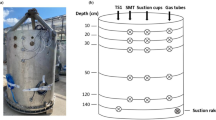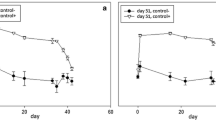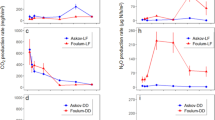Abstract
A 15N labelling technique was used to measure N2O and N2 emissions from an undisturbed grassland soil treated with cow urine and held at 30 cm water tension and 20°C in a laboratory. Large emissions of dinitrogen were detected immediately following urine application to pasture. These coincided with a rapid and large increase in soil water-soluble carbon levels, some of this increase being attributed to solubilization of soil organic matter by high pH and ammonia concentrations. Emissions of nitrous oxide generally increased with time in contrast to dinitrogen fluxes which decreased as time progressed. Estimated losses of N2O and N2 over a 30 day period were between 1 to 5% and 30 to 65% of the urine N applied plus N mineralized from soil organic matter, respectively. Most of the N2 and N2O originated from denitrification with nitrification-denitrification being of minor significance as a source of N2O. Comparisons of the 15N enrichments in the soil mineral N pools and the evolved N2O suggested that much of the N2O was produced in the 5–8 cm zone of the soil. It is concluded that established grassland soils contain large amounts of readily-oxidizable organic carbon which may be used by soil denitrifying organisms when nitrate is non-limiting and soil redox potential is lowered due to high rates of biological activity and high soil moisture contents. ei]{gnR}{fnMerckx}
Similar content being viewed by others
References
Aulakh M S, Rennie D A and Paul E A 1984 Acetylene and N-Serve effects upon nitrous oxide emissions from ammonium and nitrate treated soils under aerobic and anaerobic conditions. Soil Biol. Biochem. 16, 351–356.
Barraclough D Geens E L Davies G P and Maggs J M 1985 Fate of fertilizer nitrogen. III. The use of single and double labelled 15N ammonium nitrate to study nitrogen uptake by ryegrass. J. Soil Sci: 36, 593–603.
Burford J R and Bremner J M 1975 Relationships between the denitrification capacities of soils and total, water-soluble and readily decomposable soil organic matter. Soil Biol. Biochem. 7, 389–394.
Goreau T J, Kaplan W A, Wofsy S C, McElroy M B, Valois F W and Watson S W 1980 Production of NO2 − and N2O by nitrifying bacteria at reduced concentrations of oxygen. Appl. Environ. Microbiol. 40, 526–532.
Monaghan R M and Barraclough D 1992 Some chemical and physical factors affecting the rate and dynamics of nitrification in urine-affected soil. Plant and Soil 143, 11–18.
Parkin T B 1987 Soil microsites as a source of denitrification variability. Soil. Sci. Soc. Am. J. 51, 1194–1199.
Ryden J C 1986 Gaseous losses of nitrogen from grassland. In Nitrogen Fluxes in Intensive Grassland Systems. Eds. H.G.van derMeer, J.C.Ryden and G.C.Ennik, pp 59–73. Martinus Nijhoff, Dordrecht, The Netherlands.
Sherlock R R and Goh K M 1983 Initial emission of nitrous oxide from sheep urine applied to pasture soil. Soil Biol. Biochem. 15, 615–617.
Author information
Authors and Affiliations
Rights and permissions
About this article
Cite this article
Monaghan, R.M., Barraclough, D. Nitrous oxide and dinitrogen emissions from urine-affected soil under controlled conditions. Plant Soil 151, 127–138 (1993). https://doi.org/10.1007/BF00010793
Received:
Accepted:
Issue Date:
DOI: https://doi.org/10.1007/BF00010793




